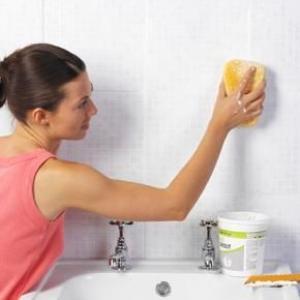Some Tips For Cleaning Your Walls and Ceilings
Generally, walls and ceilings are painted with either latex or alkyd paint. Latex, a water-base paint, is easy to wash after it has "cured" or set for a period of time. Alkyd, or oil-base paint, is durable and washable. Both types come in four finishes: flat (for walls and ceilings), satin (for doors and trim), semigloss (for walls), and gloss (for kitchen and bathroom walls and woodwork). You can clean painted walls with all-purpose cleaners.
We'll examine more than just painted surfaces in this article. From plaster to tile, we'll hit on a variety of surface types.
A Cleaner for Painted Walls and Ceilings, Here's a homemade solution that can get the dirt off painted walls and ceilings:
- Mix 1⁄2 cup vinegar, 1 cup clear ammonia, 1⁄4 cup baking soda, and 1 gallon warm water. Caution: Wear rubber gloves, and work in a well-ventilated area when using this powerful solution.
- Apply to the wall with a sponge, and rinse with clear water. If your walls have a rough texture, use old nylon stockings or socks rather than a sponge because they won't tear and leave difficult-to-remove bits on the surface.
Most painted ceiling surfaces are washable, but some ceilings, especially the acoustic type, need special treatment. Remove cobwebs from all ceilings monthly, or as needed, with a vacuum brush attachment or a long-handle mop. Wash or clean ceilings first if you are cleaning the whole room. Do not allow drips to run down walls. Protect furniture and floors with drop cloths or newspaper while you clean. Use a sponge mop to clean ceilings so you won't need a ladder.
Acoustic Finish
This rough sound-absorbing finish is often used in new construction and remodeling. While it is relatively cheap and quick to apply, spray-on acoustic finishes cannot be cleaned. When the ceiling becomes dirty, the best thing to do is to vacuum it using a brush attachment, and then respray it.
Ceiling Tile
Vinyl-coated ceiling tile can be cleaned with an all-purpose cleaning solution. Nonwashable tiles can be spot-cleaned with special products available at hardware stores. When an overall cleaning is needed, the tiles may be painted. There's no need for special paint.
Plaster
Decorative plaster ceilings -- as opposed to flat, painted plaster ceilings -- are really not cleanable because of the unpainted surface and deep texture. When a plaster ceiling becomes dirty, the best treatment is to vacuum it carefully, using a brush attachment.
Now we move on to walls, which are tougher to maintain because they generally take more abuse.
Walls require more routine cleaning than ceilings, mainly because it's a lot easier for fingerprints, crayon marks, and scuff marks to land on them. Using a brush attachment, vacuum walls when you clean the room. Go behind pictures and mirrors with the small brush attachment. Remove cobwebs monthly or as needed.
When you vacuum, be careful not to press cobwebs against the wall. When you're ready to wash the wall, use an all-purpose cleaner for cleaning washable walls. Test the product to make sure it does not harm your wall covering by washing an inconspicuous place first.
Decorative tile: Self-sticking decorator tiles, which are often vinyl-coated, are grease- and stain-resistant. A quick wipe with a sponge dipped in an all-purpose cleaning solution is usually all that is needed to keep them fresh and bright.
Metal tile: Metal tile can be wiped clean with a cloth dampened in an all-purpose cleaner and then buffed with a soft cloth.
Mirror tile: These wall tiles, whether clear or smoked, are cleaned in the same way as wall mirrors. Use glass cleaner on a paper towel or piece of newspaper to quickly remove spots and spatters. Do not use soap on mirror tile; it will streak and leave a film.






















































